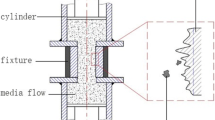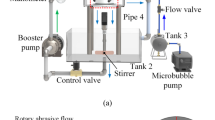Abstract
Aiming at the problem of difficult contact finishing for mini structural surface in course of mould manufacturing, a new no-tool precision machining method based on soft abrasive flow machining (SAFM) was proposed. It allocated restrained component near surface machined, constituted restrained abrasive flow passage, and made the surface become a segment of passage wall. It could control turbulence abrasive flow in restrained passage, realize micro cutting for passage wall, and utilize the irregular motion of abrasive flow to eliminate the mono-directional marks on machined surfaces, and the precision could reach the specular level. A two-phase dynamic model of abrasive flow oriented to SAFM combined with discrete phase model (DPM) was established, the law of two-phase flow motion and the related physical parameters was obtained by corresponding numerical simulation method, and the mechanism of precision machining in SAFM was discussed. Simulation results show that the abrasive flow machining process mainly appears as translation of ablating location with the influence by granular pressure, and as the variation of machining efficiency with the influence by near-wall particle velocity. Thus via control of the inlet velocity and its corresponding machining time, it is supposed to work out the machining process according to the machining requirements by using the Preston equation to seek the relationship among velocity, pressure and material removing rate. By tracking near-wall particles, it can be confirmed that the movement of near-wall abrasive particles is similar to stream-wise vortices. The cutting traces on workpiece surfaces assume disorderly arrangement, so the feasibility of the SAFM method can be reaffirmed.
Similar content being viewed by others
References
Chen Y S, Shan X W, Chen H D. New direction of computational fluid dynamics and its applications in industry. Sci China Ser E-Tech Sci, 2007, 50(5): 521–533
Jin J, Liu P Q, Lin G P. Numerical simulation of heat transfer of latent functionally thermal fluid in tubes with coaxially inserted cylindrical bars in laminar. Sci China Ser E-Tech Sci, 2008, 51(8): 1232–1240
Jain V K, Adsul S G. Experimental investigations into abrasive flow machining (AFM). Int J Mach Tool Manu, 2000, 40(7): 1003–1021
Guo Y Z. Application of abrasive flow machining in manufacture of aeroengine (in Chinese). Aeronaut Manu Tech, 1993. 5: 28–32
Rhoades L J. Abrasive flow machining: a case study. J Mater Process Tech, 1991, 28(2): 107–116
Madadnia J, Reizes J A. Feasibility study of using cavitation to increase erosion in particulate-laden water jet cutting devices. Int Conf Abrasive Tech. W Sci P Co Pte Ltd, 1999
Jones A R, Hull J B. Ultrasonic flow polishing. Ultrasonics, 1998, 36: 97–101
Wang C. Study and comparison of vibrative polishing (in Chinese). OR Tran, 1996, 5(2): 5–9
Jha S, Jain V K. Design and development of the magnetorheological abrasive flow finishing (MRAFF) process. Int J Mach Manu, 2008, 48: 415–426
Shirolkar J S, Coimbra C F M. Fundamental aspects of modeling turbulent particle dispersion in dilute flows. Prog Energy Combust Sci, 1996, 22: 363–399
Kallio G A, Stock D E. In Gas-Solid Flows. ASME FED, 1986, 35: 23
Mostafa A A. On the interaction of particles and turbulent fluid flow. Int J Heat Mass Tran, 1987, 30 (12): 2063–2075
Crowe C T. Review: Numerical models for dilute gas-particle flows. Trans ASME I: J Fluid Eng, 1982, 104: 297–303
Booij S M, van Brug H, Braat J J M. Nanometer deep shaping with fluid jet polishing. Opt Eng, 2002, 4(8): 1926–1931
Fang H, Guo P J, Yu J D. Optimization of the material removal in fluid jet polishing (in Chinese). Opt Tech, 2004, 30(2): 248–250
Toshio T, Paul D F. Micromechanics of diamond composite tools during grinding of glass. Mater Sci Eng, 2000, A285: 69–79
Burry D, Bergeles G. Dispersion of particles in anisotropic turbulent flows. Int J Multiphase Flow, 1993, 19: 651–664
Kader B. Temperature and concentration profiles in fully turbulent boundary layers. Int J Heat Mass Tran, 1981, 24(9): 1541–1544
Gatzen H H, Wu K H, Cvetkovic S. Modeling CMP — Investigation of the mechanical removal mechanism, Proc. ASPE 20th Ann Meet, Norfolk, Virginia, USA, 2005, 500–503
Kumar S, Hart D. Granular pressure measurement in fluidized beds. ASME Cavitation and Multiphase Flow Forum, 1990, FED-98: 1–6
Nikuradse J. Laws for Flows in Rough Pipes. Technical Report, NACA Technical Memorandum 1292. National Advisory Commission for Aeronautics, Washingyon DC, 1950
Gevrin F, Masbemat O. Granular pressure and particle velocity fluctuation predictions in liquid-solid fluidized beds. Chem Eng Sci, 2008, 63(9): 2450–2464
Blackwelder R F, Kaplan R E. Streamwise vortices associated with the bursting phenomenon. J Fluid Mech J Fluid Mech Digit Arch, 1976, 94: 577–594
Zhou M D, Liu D P, Blackwalder P F. An experimental study of receptivity of acoustic waves in laminar boundary layers. Exp Fluids, 1994, 17: 1–9
Kai L, Zhang N, Lu L P. Production of streamwise vortexes in a turbulent boundary layer (in Chinese). J Beijing Univ Aeronaut Astronaut, 2005, 31(110): 1800–1803
Author information
Authors and Affiliations
Corresponding author
Rights and permissions
About this article
Cite this article
Ji, S., Xiao, F. & Tan, D. Analytical method for softness abrasive flow field based on discrete phase model. Sci. China Technol. Sci. 53, 2867–2877 (2010). https://doi.org/10.1007/s11431-010-4046-9
Received:
Accepted:
Published:
Issue Date:
DOI: https://doi.org/10.1007/s11431-010-4046-9




